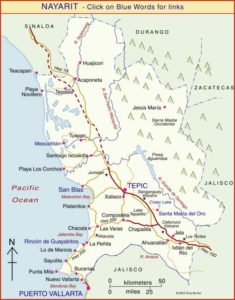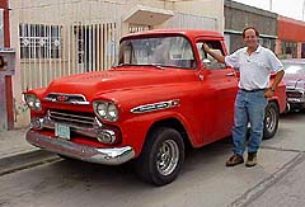Nayarit is still one of Mexico’s best kept secrets. Here you will find rich traditions, beautiful beaches, and “secret places” to discover for yourself. If you are planning a trip to explore Nayarit, you will want to consider doing it by car and taking the time to visit some of the places listed below.
Tepic
- Formerly known as Santiago de Compostela, Tepic’s name comes from the Nahuatl words tetl (rock) and pic (hard). It was founded in 1532 by Nuño Beltrán de Guzmán. While wandering down Insurgentes Avenue, which crosses the town, you can see signs that denote the influence of Fray Junipero Serra and a monument in his honor, as well as another monument dedicated to the celebrated Nayarit poet Amado Nervo and still another which represents Hermana Agua (Sister Water) one of his best poems.
A visit to the Regional Museum of Anthropology and History is a must. It exhibits a number of pieces of importance to western culture including the Venus of Nayarit. Continue your journey to the Cathedral, constructed in the 18th century and dedicated to la Purísima Concepción de María (Mary’s Immaculate Conception). Next to this is a beautiful rooftop garden, and across the street is the main square and the luxurious Municipal Palace.
Take a walk through the residential sector known as Loma de la Cruz. Here you will find an old convent that houses the famous Cruz de Zacate or “Grass Cross” which, although it has received no care, continues to grow back each year and, because of this is considered a miraculous site. The now extinct Sanganguey Volcano offers an opportunity for climbers to test their skills and a variety of festivals in the neighboring villages throughout the year, guarantee you will have a memorable visit.
Santa Maria del Oro
- Located only 41 km, from Tepic, its name originated from three mines that were exploited in the XVIII century. The main attraction is the Santa Maria Lake, which is approximately 2 km. long by 1.6 km. wide. It has a variety of beaches — some rocky, some sandy, but all very beautiful and a great place to spend some time. There is a restaurant, a trailer park for motor homes and RVs as well as other accommodations available here.
Ixtlan del Rio
- Along the same road is Ixtlán del Río. Here you will find thermal waters, thanks to its location near the Ceboruco Volcano. The major attraction is its archeological zone, which is though to have flourished around the year 1000. It is made up of various constructions, the most notable of which is the round temple dedicated to Quetzalcoatl. It has two centers of worship on the upper level and a ceremonial center of a much older construction inside. Ixtlán also houses the main airstrip used to fly over the Huichol and Cora mountains
La Yesca
- Within walking distance of Ixtlán del Río, La Yesca is known for its red tile roofed houses and for the nearby mountain which shares its name. At its highest point, this mountain reaches 2,830 m. above sea level. In town, you can visit the cathedral and climb to the roof, a beautiful vantage point from which to see the city.
Ceboruco Volcano
- Near the town of Jala and 102 km. from Tepic, the Ceboruco Volcano is reached via an 11 km. dirt road which goes up the side of the mountain. While on this road you will be able to appreciate the vegetation as well as the areas covered by red lava spewed by the volcano during its last eruption in 1879. If you like to climb, you will find a path just beyond the craters near a microwave station.
Compostela
- Located 37 km. from Tepic, its name was derived from the capitol of Nueva Galicia and Compostela was founded in 1540 by Cristóbal de Oñate. Its main attraction is the Cathedral, which was constructed in the XVI century. Compostela is also near various Nayarit beaches.
Las Varas
- Only 30 km. from Compostela, Las Varas is known as an important tobacco center. Discovered in 1524 by Francisco Cortes de Buenaventura, it is currently an archeological, shrimping and tourist center that very few people know about. Nearby in Las Piedras is a zoo which houses magnificent specimens of local fauna.
Rincon de Guayabitos
- 25 km. from Las Varas on the Costa Alegre or Happy Coast is Rincón de Guayabitos. It is an area which is commonly visited by tourist and as such, has all the amenities.
Bucerias
- A beautiful beach located on the Bahia de Banderas only 68 km. from Rincón de Guayabitos. Getting here is half the fun, as you will be able to admire the lush vegetation which grows alongside the coastal highway. Although there is not a lot of tourist infrastructure, it is a beautiful place to enjoy the beach.
San Blas
- San Blas was founded in the mid XVII century and is the main tourist center in Nayarit because of the beauty of its beaches and countryside. Water sports abound and there are many seaside restaurants which specialize in serving up the local seafood delicacies. The vestiges of fortifications can be seen in the Cerro de Contaduría, as the port of San Blas was heavily pirated. Don’t miss a visit to the Baroque Cathedral — Nuestra Señora la Marinera — either. At the foot of these mountains is the pier where you can embark on a journey to La Tovara. This journey will take you through foliage-covered tunnels to the Ojo de Agua de Piedra Caliza spring where you can swim. San Blas offers great seafood and shopping as well, and is only 87 km. from Tepic.
El Cora
- A short drive from Tepic to see this spectacular waterfall is very worth while. The 120 m. basaltic rock face over which the water cascades, along with the lush vegetation, create an unforgettable landscape. There is a funicular that will take you to the top.
Acaponeta
- A good spot for hunting deer, duck and a variety of other game, you can also find some unexploited silver and gold mines on the outskirts of town.
Huajicori
- You must take a dirt road to arrive at Huajicori but once there you can see the famous Piedra de la Teposilama. According to local lore, this stone represents a woman who, having repented for going to see the Virgin, turned to stone without being able to return to her village. Here you can also visit the most beautiful Baroque temple in Nayarit, which houses the image of the Virgin of the Candelaria, made of corn paste. Thousands of pilgrims each year visit this cathedral and on the 2nd of February, Candlemas, people show up in native dress and celebrate her.
- The name Huajicori means “In the house of the moon.” This island, situated about 30 minutes off the coast, is characterized by the layout of its streets — one circular and four straight — that lead from the center of town outward. On the 29th of June, the local fishermen carry statues of Saint Peter and Saint Paul in their boats and compete for the best shrimp catch of the day — a unique way of honoring these two saints and a wonderful tradition to witness.


